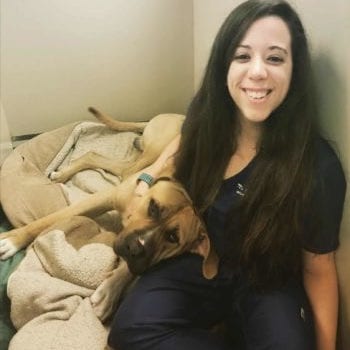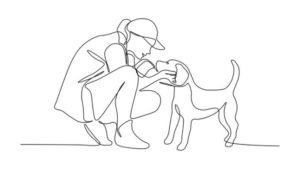Parvovirus, referred to as parvo, is a viral disease of dogs that affects puppies due to their weakened immune system. Unvaccinated adult dogs are also susceptible to parvo. Parvo is a debilitating infection that is not only highly contagious but deadly.
While many pets do need in-patient care for parvo, you may be wondering how you can cure the infection without needing to keep your pet hospitalized. Your Veterinarian will ultimately be able to determine the best course of action for your pet. Your only other option is to treat parvo at home for those who cannot afford a vet.
The parvovirus embeds into your dog's intestinal lining, causing severe irritation and inflammation to the gastrointestinal tract. Parvo causes explosive and bloody diarrhea, vomiting, nausea, hyperthermia (fever), lethargy, and inappetence.
Parvo prohibits your pet from maintaining their normal nutritional levels through their frequent bouts of diarrhea and vomiting.
As your dog loses their inability to keep their hydration levels regular, you may notice their core body temperature drops significantly as they begin to decompensate.

Parvo has a high fatality rate, taking your dog to the Vet is necessary to confirm the diagnosis to initiate treatment.
Your Vet will determine the diagnosis by testing a sample of your dog's stool for the novel parvovirus and other intestinal parasites. A fecal sample will be directly obtained from your dogs' anus and placed into a particular device known as an ELISA (Enzyme-linked immunosorbent assay) test that detects and measures antibodies in the sample related to a specific disease. This test takes roughly 10 minutes to complete. It will confirm whether your dog truly has parvo or another form of gastrointestinal illness such as intestinal obstruction or parasite, as these concerns have similar symptoms.
Because your dog may be highly contagious, you will be asked to wait out in the car while the initial tests occur. Keeping your pet in your vehicle ensures that any unvaccinated animals coming into the Vet are kept safe while visiting the hospital.

After your dog has been diagnosed with parvo and depending on the severity of their symptoms, there are two ways that the parvovirus can be treated; in-patient hospitalization at your Vet, or by treating them at home. The gold standard care treatment option is to have your dog hospitalized for a few days until their symptoms improve. When your dog is hospitalized, they receive intravenous (IV) fluids throughout their stay and injectable medications such as antibiotics, vitamins, anti-nausea, and antiemetic drugs. This treatment method is proven to be highly effective in treating parvo as many patients cannot keep oral medications down due to their constant vomiting. Your dog will also be handfed calorie-dense food and supplementation every few hours to ensure their nutritional levels are stable. Even though your pet may not want to eat, the antiemetic medications will allow for your pet to retain most of the nutrients they are being given by mouth. An appetite stimulate may be used to coax your dog into eating on their own once they have enough strength to do so.
Dogs with parvo tend to become severely dehydrated due to their constant and explosive vomiting and diarrhea. IV fluids assure that their fluid loss is minimized due to it being replaced continuously.
Rest assured, your dog will receive plenty of attention and love from the veterinary staff despite being in isolation. In-patient treatment provides a higher rate of overall success for treating parvo.
The at-home treatment has a much lower success rate than in-patient hospitalization. This may be your only option due to cost constraints. But it requires 24/7 care until they are completely cured of the virus. If you're up for the task and understand the risks, and your Vet has deemed it safe for your pet to go home, at-home care may be an option.
Your Vet will be able to provide you with the proper medications and necessary supplies for at-home parvo treatment. Your dog will be sent home with a bag of medical-grade fluids to be given under your pet's skin, drugs that may or may not be added to the fluids already, fluid lines, needles for fluid administration. High-calorie foods and oral supplements will also help to make this method of treatment as successful as possible.
The cost of keeping your dog in the clinic for a few days to treat parvo will cost about $1,300-3,200. It will be in, or above, the higher range if your dog stays at an emergency or specialty facility. The estimate will be closer to the lower end if they remain at a general practice vet clinic. But 24/7 supportive care will most likely not be an option at a general practice vet clinic as many are only open during regular working hours and are closed on Sundays.
The cost of treating your dog for parvo at home will be approximately $500-900. This estimate includes the initial trip to the Vet for the diagnosis, plus the medications they send home with your dog.
As mentioned previously in this article, treating parvo at home will require an immense amount of dedication after your dogs' initial appointment with the Vet. Once your Vet confirms the diagnosis, they can prepare your supplies and medications to treat your dog at home.
A descriptive list of the before-mentioned treatments can be found below:
Your Vet will give you a bag of medical-grade fluids, an IV line, and a supply of needles. They will label the fluids to show how much of the fluids you should give to your dog and how many times daily. The amount of fluids that will be given will be determined by your pets' weight and dehydration status. Your veterinary staff will connect the IV line to the fluid bag and demonstrate how to administer the fluids so that you can mirror their technique at home.
Multiple times a day, you will need to give the prescribed amount of fluids under your dogs' skin. The best place to administer the fluids is between their shoulder blade, in the scruff area, as there is plenty of excess skin located here.
To administer fluids at home, you will first put a fresh needle on the end of the IV line that should already be connected to the fluid bag. Ensure there are no bubbles in the fluid line as these can be dangerous in pets of all sizes.
Next, you will lift your pets' skin with your non-dominant hand and place the needle under the skin, with the bevel (point of the needle facing up), at a 45-degree angle with your dominant hand. Finally, unkink the fluid line and administer the fluids as recommended. Ensure you are giving your dog the prescribed amount of fluids to ensure treatment is successful, and do not give more than recommended as to not fluid-overload your dog.
Remember, the fluids are one of the most critical aspects of treatment as many pets who die from the parvovirus pass due to dehydration. By staying on top of their fluids, you can ensure they have the best chance of surviving parvo.
Before leaving the hospital at the time of diagnosis, your Vet will likely give your dog the first injection of antibiotics prior to being discharged. The antibiotic may be given under the skin (subcutaneously), intravenously, or into a muscle, depending on the medication. This will allow your pet to begin circulating the medication in their system to keep any oral medications down. Antibiotics are used to fend off any bacterial infection your dog may develop from the parvovirus. Without antibiotic treatment, the bacteria may migrate from the intestines and into the bloodstream, causing sepsis.
The course of antibiotics you will give while your pet is at home fighting the parvovirus should last roughly 7-14 days and be given 2-3 times daily. If your dog is too nauseous to take their antibiotics, consider giving the anti-nausea medication an hour or two beforehand.
Giving oral medications may be easier than you anticipate, as your dog will most likely be relatively weak from parvo. To administer oral antibiotics, you will need to open your dog's mouth by placing your non-dominant thumb and pointer finger on either side of their upper jaw, with your fingers behind their canines (sharp teeth in the front of the mouth). Secondly, place the medication(s) at the fingertips of your dominant hand and place the pill in the back of their throat. Quickly and gently close their mouth and rub your dogs' throat to encourage them to swallow the medication. Having an oral syringe filled with water is a great tool to use if your pet does not want swallow. Slowly dispense the water into their mouth, behind the canine teeth.
Your pet may also be sent home with an anti-diarrheal medication used to stave off the rapid fluid loss seen with parvo.
Probiotics can help reestablish the balance of the normal gastrointestinal flora, which will also help combat your dogs' debilitating diarrhea.
Like the antibiotic shot, your Vet will also give your dog an injection of an anti-nausea medication before leaving the hospital. You will be sent home with a prescription of anti-nausea medication that is generally prescribed as long as the antibiotic course, 14 days.
This medication can be given as frequently as the antibiotic. 2-3 times daily. The anti-nausea medicine is just as crucial as the antibiotic as it will encourage your dog to start eating sooner and allow them to replenish their depleted nutrients.
Depending on how painful your pet is, your Vet may also prescribe a short course of pain medications. By controlling your pets' pain, the goal is to encourage them to eat sooner.
Remember that human pain medications are toxic to dogs. If you feel a pain medication is needed, your Vet can prescribe a dog-specific one to help ease any pain or discomfort.
Once your dog is not excessively vomiting, you must encourage them to eat. Offering a small portion of canned food every 2 hours will enable their appetite.
You may need to force-feed your pet a small amount of canned food to get them to want to eat. It is recommended to add water to the food to make it a "slurry" for easier oral administration.
Nutritional supplementation is crucial for dogs suffering from parvo. This will encourage your dogs' intestines to reestablish normal motility and allow for healing through energy supplementation.
When taking your dog home following a parvovirus diagnosis, your pet will need to be isolated to one area of the house, away from any other unvaccinated dogs. Your dog should be isolated until their parvo has entirely resolved, and at your Vet's recommendation.
Once your pup starts feeling better and no longer has diarrhea, you will need to give them a suitable bath to wash away any remaining parvo particles on their fur. Ensure disinfecting the area they were treated with diluted bleach to kill off any remaining viral particles. It would be best if you also disinfected areas of your yard where your dog defecated during this time. The last thing you want is for another susceptible dog to get infected with parvo by going around your yard.

Nicole is a Licensed and Registered Veterinary Technician in Washington and California. She is the immediate past president of the Washington State Association of Veterinary Technicians and holds multiple advanced degrees in veterinary technology, psychology, and human health care management. She has worked in private and corporate settings. Nicole manages an ambulatory surgery practice based in the Puget Sound area of Washington. When not working in the clinic, Nicole is a frequent lecturer at various national and international conferences and meetings. She is also a tireless advocate for the appropriate use of regenerative therapies in veterinary medicine.
